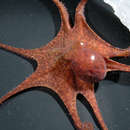Comprehensive Description
(
Inglês
)
fornecido por Smithsonian Contributions to Zoology
Octopus oliveri (Berry, 1914)
DIAGNOSIS.—Animal small to medium-sized (“dorsal length of body” 27–30 mm (Berry, 1914b:136)). Mantle broad (MWI 103–137), pyriform, widest posteriorly; neck weakly constricted; head short, narrower than mantle (HWI 77–89); eyes elevated, with small, puckered openings. Arms short (ALI about 75), stout, tapering abruptly near tips, arm formula II = III > I = IV; proximal 4 suckers on each arm uniserial, suckers biserial distally. Web thick, shallow. Dorsal surface of mantle and head with numerous conical papillae; eye surrounded by circumocular ring of 5 to 6 low, individual papillae, supraocular papillae absent; ventral surface smooth. Color dark slate dorsally, lighter ventrally. Inner surface of suckers light brown to cream.
ORIGINAL DESCRIPTION.—Berry, 1914b:136, as Polypus oliveri.
TYPE LOCALITY.—Sunday Island, Kermadec Islands (intertidal among rocks).
TYPE.—Holotype: USNM 816455, female, 30 mm ML, SSB no. 405.
DISTRIBUTION.—In addition to the type locality, Okutani etal. (1987) attributed a specimen from Ishigaki Island, Okinawa, to this species.
- citação bibliográfica
- Voss, N. A. and Sweeney, M. J. 1998. "Systematics and Biogeography of cephalopods. Volume II." Smithsonian Contributions to Zoology. 277-599. https://doi.org/10.5479/si.00810282.586.277
Octopus oliveri
(
Inglês
)
fornecido por wikipedia EN
Octopus oliveri, is a species of octopus found in the western Pacific Ocean off the coast of Japan, Hawaii, and Kermadec Island, in reefs and boulder coasts.[1][2]
It is a small species, roughly 70-260mm in length.[2] Females will take longer to mate, the larger their body size.[2][3] Afterwards, ~5000 eggs will hatch in about five weeks after being laid, and the male/female ratio seems unaffected by temperature. These eggs are laid in strings attached to a hard substrate.[2][4]
References
-
^ "Octopus oliveri". www.sealifebase.ca. Retrieved 2019-10-17.
-
^ a b c d Ylitalo, Heather A.; Watling, Les; Toonen, Robert J. (2014-04-03). "First description of hatchlings and eggs of Octopus oliveri (Berry, 1914) (Cephalopoda: Octopodidae)". Molluscan Research. 34 (2): 79–83. doi:10.1080/13235818.2013.860871. ISSN 1323-5818.
-
^ Ylitalo, Heather; Oliver, Thomas A.; Fernandez-Silva, Iria; Wood, James B.; Toonen, Robert J. (2019-06-07). "A behavioral and genetic study of multiple paternity in a polygamous marine invertebrate, Octopus oliveri". PeerJ. 7: e6927. doi:10.7717/peerj.6927. ISSN 2167-8359. PMID 31211008.
-
^ Ylitalo-Ward, Heather Anne (December 2014). Life history, mating behavior, and multiple paternity in Octopus oliveri (Berry, 1914) (Cephalopoda : Octopodidae) (Thesis thesis). [Honolulu] : [University of Hawaii at Manoa], [December 2014].
- Norman M.D. & Hochberg F.G. (2005) The current state of Octopus taxonomy. Phuket Marine Biological Center Research Bulletin 66:127–154
- Norman M.D., Finn J.K. & Hochberg F.G. (2014). Family Octopodidae. pp. 36–215, in P. Jereb, C.F.E. Roper, M.D. Norman & J.K. Finn eds. Cephalopods of the world. An annotated and illustrated catalogue of cephalopod species known to date. Volume 3. Octopods and Vampire Squids. FAO Species Catalogue for Fishery Purposes [Rome, FAO]. 4(3): 353 pp. 11 pls.
- Spencer, H.G., Marshall, B.A. & Willan, R.C. (2009). Checklist of New Zealand living Mollusca. pp 196–219. in: Gordon, D.P. (ed.) New Zealand inventory of biodiversity. Volume one. Kingdom Animalia: Radiata, Lophotrochozoa, Deuterostomia. Canterbury University Press, Christchurch.

- licença
- cc-by-sa-3.0
- direitos autorais
- Wikipedia authors and editors
Octopus oliveri: Brief Summary
(
Inglês
)
fornecido por wikipedia EN
Octopus oliveri, is a species of octopus found in the western Pacific Ocean off the coast of Japan, Hawaii, and Kermadec Island, in reefs and boulder coasts.
It is a small species, roughly 70-260mm in length. Females will take longer to mate, the larger their body size. Afterwards, ~5000 eggs will hatch in about five weeks after being laid, and the male/female ratio seems unaffected by temperature. These eggs are laid in strings attached to a hard substrate.
- licença
- cc-by-sa-3.0
- direitos autorais
- Wikipedia authors and editors
Octopus oliveri
(
Neerlandês; Flamengo
)
fornecido por wikipedia NL
Octopus oliveri is een soort in de taxonomische indeling van de inktvissen, een klasse dieren die tot de stam der weekdieren (Mollusca) behoort. De inktvis komt enkel in zout water voor en is in staat om van kleur te veranderen. Hij beweegt zich voort door water in zijn mantel te pompen en het er via de sifon weer krachtig uit te persen. De inktvis is een carnivoor en zijn voedsel bestaat voornamelijk uit vis, krabben, kreeften en weekdieren die ze met de zuignappen op hun grijparmen vangen.
De inktvis komt uit het geslacht Octopus en behoort tot de familie Octopodidae. Octopus oliveri werd in 1914 beschreven door Berry.[1]
Bronnen, noten en/of referenties
- licença
- cc-by-sa-3.0
- direitos autorais
- Wikipedia-auteurs en -editors

